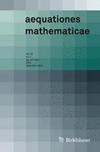利用 Csiszár f-发散的正同次正函数的进一步结果
IF 0.9
3区 数学
Q2 MATHEMATICS
引用次数: 0
摘要
在Kluza和Niezgoda(数学不等式应用21(2):455-467,2018)和Marinescu等人(J数学不等式:151 - 159,2013)的推动下,我们利用Csiszár的f-散度的最新结果证明了一变量或两个变量的正齐次可加函数的Sherman型定理。特别地,我们通过用入口正矩阵代替随机矩阵,为这些函数提供了Hardy-Littlewood-Pólya-Karamata (HLPK)定理的扩展。作为应用,我们提出了一些经典不等式的HLPK型结果(Radon, Milne, Hölder, Minkowski, Tsallis, Hellinger),它发展了Marinescu等人(2013)的方法和理论。本文章由计算机程序翻译,如有差异,请以英文原文为准。
Further results on positively homogeneous subadditive functions by using Csiszár f-divergence
In this paper, motivated by Kluza and Niezgoda (Math Inequal Appl 21(2):455–467, 2018) and Marinescu et al. (J Math Inequal 7:151–159, 2013), we prove Sherman type theorems for positively homogeneous subadditive functions of one or two variables using recent results on Csiszár’s f-divergence. In particular, we provide an extension of the Hardy–Littlewood–Pólya–Karamata (HLPK) theorem for such functions by replacing stochastic matrices with entrywise positive ones. As applications, we present results of HLPK type for some classical inequalities (Radon, Milne, Hölder, Minkowski, Tsallis, Hellinger), which develops the methods and theory of Marinescu et al. (2013).
求助全文
通过发布文献求助,成功后即可免费获取论文全文。
去求助
来源期刊

Aequationes Mathematicae
MATHEMATICS, APPLIED-MATHEMATICS
CiteScore
1.70
自引率
12.50%
发文量
62
审稿时长
>12 weeks
期刊介绍:
aequationes mathematicae is an international journal of pure and applied mathematics, which emphasizes functional equations, dynamical systems, iteration theory, combinatorics, and geometry. The journal publishes research papers, reports of meetings, and bibliographies. High quality survey articles are an especially welcome feature. In addition, summaries of recent developments and research in the field are published rapidly.
 求助内容:
求助内容: 应助结果提醒方式:
应助结果提醒方式:


